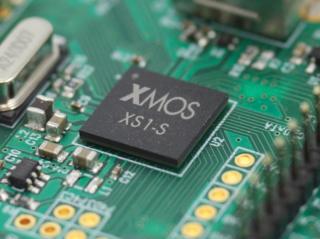XMOS Ltd
 XMOS provides embedded voice controllers and audio interfaces for consumer electronics. The unique xCORE architecture and highly differentiated software delivers class-leading far field voice capture and the highest quality digital multi-channel audio interfaces. VocalFusion voice controllers position XMOS at the interface between embedded voice processing, biometrics and artificial intelligence, with flexible integration to automatic speech recognition (ASR) systems.
XMOS provides embedded voice controllers and audio interfaces for consumer electronics. The unique xCORE architecture and highly differentiated software delivers class-leading far field voice capture and the highest quality digital multi-channel audio interfaces. VocalFusion voice controllers position XMOS at the interface between embedded voice processing, biometrics and artificial intelligence, with flexible integration to automatic speech recognition (ASR) systems.
XMOS provides:
XMOS has developed families of silicon devices and software based on its xCORE technology:
- xCORE VocalFusion™ - xCORE VocalFusion (XVF) devices combine far-field voice capture technologies and acoustic digital signal processing (DSP) in a single device that can also include support for Sensory, Inc. TrulyHandsfree Voice Control. VocalFusion became Amazon Alexa Voice Services (AVS) qualified in October 2017.[12]
- xCORE-VOICE™ - xCORE-VOICE processors are a combination of one or more xCORE-200 processors with software that enables capture of multiple microphone signals, and aggregate those into a single signal.
- xCORE-AUDIO™ - xCORE-AUDIO are audio-specific processors built on xCORE-200 technology, aimed at high-resolution consumer audio and multichannel professional audio applications.
- xCORE-200™ – The general purpose xCORE-200 devices can execute dual-issue code at 500 MHz, have up to four tiles, with each tile executing up to eight concurrent tasks. The devices are packaged with options for embedded flash, embedded USB PHY, and an embedded RGMII interface.
Product Features
xCORE multicore microcontrollers comprise one or more processor tiles connected by a high-speed switch. Each processor tile is a conventional RISC processor that can execute a up to eight tasks concurrently. Tasks can communicate with each other over channels (that can connect to tasks on the local tile, or to tasks on remote tiles), or using memory (within a tile only).
The xCORE architecture delivers, in hardware, many of the elements that are usually seen in a real-time operating system (RTOS). This includes the task scheduler, timers, I/O operations, and channel communication. By eliminating sources of timing uncertainty (interrupts, caches, buses and other shared resources), xCORE can provide deterministic and predictable performance for many applications. A task can typically respond in nanoseconds to events such as external I/O or timers. This makes it possible to program xCORE devices to perform hard real-time tasks that would otherwise require dedicated hardware.
xCORE devices have been used in a range of different markets, including voice processing, USB Audio, AVB and Time-Sensitive Networking, industrial communications, and robotics.

